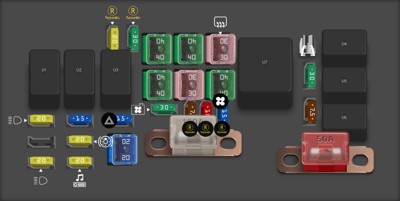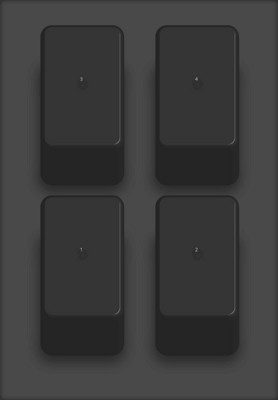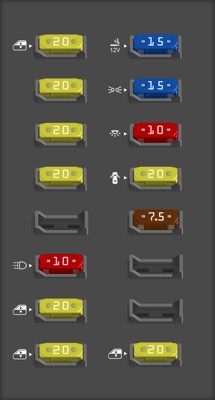Understanding your 2004 Honda Pilot’s electrical system is crucial for maintenance and troubleshooting. Two key components in this system are the fuse boxes and the OBD2 port. Fuses protect your vehicle’s electrical circuits from overloads, while the OBD2 port is essential for diagnostics and accessing your car’s computer system. This guide provides a detailed overview of the fuse box locations and diagrams, along with the OBD2 port location in your 2004 Honda Pilot, ensuring you have the necessary information at your fingertips.
Decoding the Fuse Boxes of Your 2004 Honda Pilot
The 2004 Honda Pilot is equipped with not one, but four distinct fuse boxes, each serving different circuits within the vehicle. Knowing the location and function of each fuse box is vital for quickly identifying and resolving electrical issues. Below, we break down each fuse box with its diagram and fuse descriptions.
Primary Under-hood Fuse Box
The primary under-hood fuse box is located in the engine compartment, usually near the battery. This box houses fuses that protect critical systems, often related to the engine and essential vehicle functions.
| Type | Description |
|---|---|
| Fuse MINI 20A | 1 Spare Fuse |
| Fuse MINI 30A | 2 Spare Fuse |
| Fuse MINI 20A | 3 Right Headlight |
| Fuse MINI 15A | 4 ACGS |
| Fuse MINI 15A | 5 Hazard |
| Fuse MINI 20A | 7 Stop |
| Fuse MINI 20A | 8 Left Headlight |
| Fuse MINI 20A | 9 Radio |
| Fuse FMX/JCase 40A | 10 Power Window Motor |
| Fuse FMX/JCase 40A | 11 Power Seat |
| Fuse FMX/JCase 30A | 12 Rear Defroster |
| Fuse FMX/JCase 40A | 13 Back Up, ACC |
| Fuse FMX/JCase 30A | 14 Rear A/C |
| Fuse FMX/JCase 40A | 15 Heater Motor |
| Fuse MINI 30A | 16 Cooling Fan |
| Fuse MINI 7.5A | 17 Spare Fuse |
| Fuse MINI 10A | 18 Spare Fuse |
| Fuse MINI 15A | 19 Spare Fuse |
| Fuse FLD/PAL 283 120A | 20 Battery |
| Fuse MINI 30A | 21 Condenser Fan |
| Fuse MINI 7.5A | 22 MG Clutch |
| Fuse FLD/PAL 283 50A | 23 IGI Main |
| Fuse FMX/JCase 20A | 24 Trailer (accessory) |
| Fuse puller | FUSE PULLER Extraction tool for fuse replacement. |



This primary fuse box under the hood of your 2004 Honda Pilot manages high-amperage fuses and relays critical for vehicle operation, including headlights, power windows, and engine cooling systems. Always ensure the vehicle is off and the ignition is cool before accessing or replacing fuses in this location.
Secondary Under-hood Fuse Box
Alongside the primary fuse box, a secondary under-hood fuse box further distributes power and protects additional circuits in the engine compartment.
| Type | No. | Description |
|---|---|---|
| Relay | 1 | ABS Motor |
| Relay | 2 | ABS F/S |
| Relay | 3 | Rear ACC Socket |
| Relay | 4 | 4WD |
This secondary fuse box, also located in the engine bay of your 2004 Pilot, primarily houses relays. These relays control systems like the Anti-lock Braking System (ABS), rear accessory socket, and the 4-Wheel Drive (4WD) system, contributing to vehicle safety and convenience features.
Interior Fuse Box – Driver’s Side
Moving inside the vehicle, you’ll find an interior fuse box located on the driver’s side. This fuse box is typically situated beneath the dashboard, often accessible by opening the driver’s side door and looking at the side panel of the dashboard.
| Type | No. | Description |
|---|---|---|
| Fuse MINI 15A | 1 | Fuel Pump |
| Fuse MINI 10A | 2 | SRS |
| Fuse MINI 7.5A | 3 | Heater Control, A/C Clutch Relay, Cooling Fan Relay |
| Fuse MINI 7.5A | 4 | Power Mirror, VTM-4 |
| Fuse MINI 7.5A | 5 | Daytime Running Light [On Canadian models] |
| Fuse MINI 15A | 6 | ECU (PCM), Cruise Control |
| Fuse MINI 7.5A | 7 | OPDS, Rear Wiper |
| Fuse MINI 7.5A | 8 | ACC Relay |
| Fuse MINI 10A | 9 | Back-up Lights, Instrument Lights |
| Fuse MINI 7.5A | 10 | Turn Signals |
| Fuse MINI 15A | 11 | IG Coil |
| Fuse MINI 30A | 12 | Front Wiper |
| Fuse MINI 7.5A | 13 | Starter Signal |
The interior fuse box on the driver’s side of your 2004 Honda Pilot protects numerous circuits related to driving and safety. This includes fuses for the fuel pump, Supplemental Restraint System (SRS), engine control unit (ECU), and critical lighting and signaling systems.
Interior Fuse Box – Passenger’s Side
Finally, the fourth fuse box is located inside the cabin on the passenger’s side. Similar to the driver’s side interior fuse box, it’s usually found under the dash, accessible from the passenger side.
| Type | No. | Description |
|---|---|---|
| Fuse MINI 20A | 1 | Driver’s Power Window |
| Fuse MINI 20A | 2 | Driver’s Power Seat Reclining |
| Fuse MINI 20A | 3 | Heated Seat |
| Fuse MINI 20A | 4 | Driver’s Power Seat Sliding |
| Fuse MINI 10A | 6 | Daytime Running Light [On Canadian models] |
| Fuse MINI 20A | 7 | Driver’s side Rear Power Window |
| Fuse MINI 20A | 8 | Front Passenger’s Power Window |
| Fuse MINI 15A | 9 | Front Accessory Socket, Radio |
| Fuse MINI 15A | 10 | Small Light |
| Fuse MINI 10A | 11 | Interior Light, Navi |
| Fuse MINI 20A | 12 | Power Door Lock |
| Fuse MINI 7.5A | 13 | Back Up |
| Fuse MINI 20A | 16 | Passenger’s Side Rear Power Window |
The interior fuse box on the passenger side of the 2004 Honda Pilot manages fuses primarily for convenience and comfort features. This includes power windows, power seats, radio, interior lighting, and the power door lock system.
Finding the OBD2 Port Location in Your 2004 Honda Pilot
The OBD2 (On-Board Diagnostics II) port is a standardized connector used to access your vehicle’s computer for diagnostics and emissions testing. For the 2004 Honda Pilot, the OBD2 port is typically located inside the cabin on the driver’s side.
Specifically, you can find it beneath the dashboard, usually near the steering column. It is often positioned in the area above the pedals, and you might need to look under the dash panel to locate it. The OBD2 port is usually a 16-pin trapezoidal connector.
Having easy access to both your fuse box locations and OBD2 port is essential for maintaining your 2004 Honda Pilot and performing basic troubleshooting. By understanding these locations, you can efficiently address electrical issues and utilize diagnostic tools to keep your vehicle running smoothly. Remember to always consult your owner’s manual for the most accurate information specific to your vehicle.
